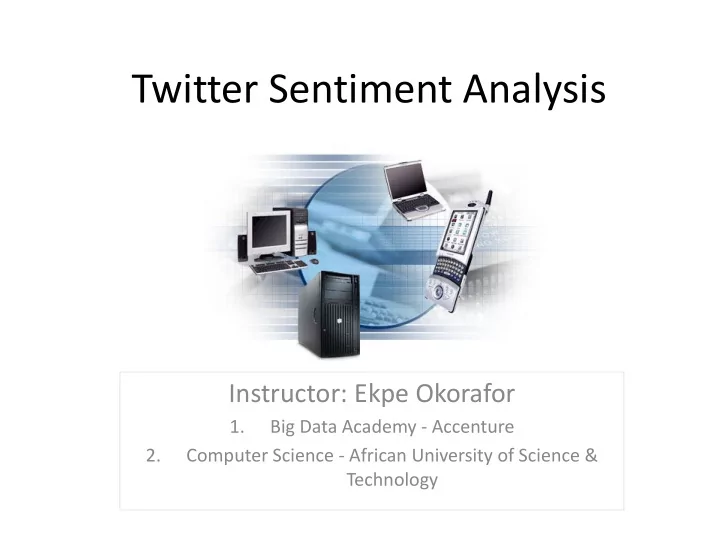

Twitter Sentiment Analysis Instructor: Ekpe Okorafor 1. Big Data Academy - Accenture 2. Computer Science - African University of Science & Technology
Ekpe Okorafor PhD Affiliations: • Accenture – Big Data Academy Senior Principal & Faculty, Applied Intelligence • African University of Science & Technology Visiting Professor, Computer Science / Data Science Research Professor - High Performance Computing Center of Excellence Research Interests: • • Big Data, Predictive & Adaptive Analytics High Performance Computing & Network Architectures • • Artificial Intelligence, Machine Learning Distributed Storage & Processing • • Performance Modelling and Analysis Massively Parallel Processing & Programming • • Information Assurance and Cybersecurity. Fault-tolerant Systems Email: ekpe.okorafor@gmail.com; eokorafo@ictp.it; eokorafor@aust.edu.ng Twitter: @EkpeOkorafor; @Radicube
Agenda • Introduction • Twitter Sentiment Analysis • Use Cases 3
Agenda • Introduction • Twitter Sentiment Analysis • Use Cases 4
Terms Sentiment ▪ A thought, view, or attitude, especially one based mainly on emotion instead of reason Sentiment Analysis ▪ aka opinion mining ▪ use of natural language processing (NLP) and computational techniques to automate the extraction or classification of sentiment from typically unstructured text
Motivation This is by no means exhaustive! Consumer information ▪ Product reviews Marketing ▪ Consumer attitudes ▪ Trends Politics ▪ Politicians want to know voters’ views ▪ Voters want to know politicians’ stances and who else supports them Social ▪ Find like-minded individuals or communities
Problem Which features to use? ▪ Words (unigrams) ▪ Phrases/n-grams ▪ Sentences How to interpret features for sentiment detection? ▪ Bag of words (IR) ▪ Annotated lexicons (WordNet, SentiWordNet) ▪ Syntactic patterns ▪ Paragraph structure
Challenges Harder than topical classification, with which bag of words features perform well Must consider other features due to… ▪ Subtlety of sentiment expression • irony • expression of sentiment using neutral words ▪ Domain/context dependence • words/phrases can mean different things in different contexts and domains ▪ Effect of syntax on semantics
Approaches Machine learning ▪ Naïve Bayes Assume pairwise ▪ Maximum Entropy Classifier independent features ▪ SVM ▪ Markov Blanket Classifier • Accounts for conditional feature dependencies • Allowed reduction of discriminating features from thousands of words to about 20 (movie review domain) Lexicon-based ▪ Dictionary ▪ Corpus Hybrid
Machine Learning Approach Advantages: ▪ Tend to attain good predictive accuracy • Assuming you avoid the typical ML mishaps (e.g., over/under-fitting) Disadvantages: ▪ Need for training corpus • Solution: automated extraction (e.g., Amazon reviews, Rotten Tomatoes) or crowdsourcing the annotation process (e.g., Mechanical Turk) ▪ Domain sensitivity • Trained models are well-fitted to particular product category (e.g., electronics) but underperform if applied to other categories (e.g., movies) • Solution: train a lot of domain-specific models or apply domain-adaptation techniques • Particularly for Opinion Retrieval, you’ll also need to identify the domain of the query! ▪ Often difficult/impossible to rationalize prediction output 10
Lexicon Based Approach Advantages: ▪ Can be fairly accurate independent of environment ▪ No need for training corpus ▪ Can be easily extended to new domains with additional affective words • e.g., “amazeballs” ▪ Can be easy to rationalise prediction output ▪ More often used in Opinion Retrieval (in TREC, at least!) Disadvantages: ▪ Compared to a well-trained, in-domain ML model they typically underperform ▪ Sensitive to affective dictionary coverage 11
Hybrid Approach 12
Agenda • Introduction • Twitter Sentiment Analysis • Use Cases 13
Introduction Social Media ▪ User-generated content ▪ Research Areas • Opinion Mining (OM) – subjectivity analysis • Sentiment Analysis (SA) – sentiment polarity detection Twitter ▪ Popular microblog ▪ Opinions on various topics Twitter Sentiment Analysis (TSA) ▪ Analyze messages posted on Twitter ▪ Short length ▪ Informal type 14
Introduction The majority of TSA methods use a method from the field of machine learning, known as classifier. 15
Implementation - Architecture Modules Kafka twitter streaming producer Sentiment analysis consumer Scala play server consumer 16
Data Flow 4 3 2 1 1. Kafka twitter streaming producer publishes streaming tweets on the ‘tweets’ topic to the central Apache Kafka , and sentiment analysis consumer has subscribed that ‘tweets’ topic. 2. The sentiment analysis consumer leverage Apache Spark Streaming to perform batch processing on incoming tweets and load trained Naive Bayes model to perform sentiment analysis. 3. And then accumulated count of each positive sentiment and negative sentiment reduced by each location are published on topic ‘sentiment’ to central Kafka, and this ‘sentiment’ topic subscribed by Scala Play Server. 4. The sentiment analysis results will be send to web clients through webSocket connections. 17
Machine Learning - Classifier Bayes’ theorem describes the probability of an event, based on conditions that might be related to the event: Naive Bayes - family of probabilistic classifiers of supervised learning algorithms based on applying Bayes’ theorem with the “naive” assumption of independence between every pair of features solving classification problem. Apache Spark MLlib supports Multinomial Naive Bayes and Bernoulli Naive Bayes. 18
Real Time Streaming – Spark Streaming Spark Streaming ▪ Spark streaming leverages spark core to perform streaming analysis. Discretized Stream or DStream is the basic abstraction provided by Spark Streaming. ▪ Each RDD in a DStream contains data from a certain interval ▪ Any operation applied on a DStream translates to operations on the underlying RDDs. 19
Agenda • Introduction • Twitter Sentiment Analysis • Use Cases 20
Use Cases – Public Health 21
Use Cases – Smart Cities Governments across the world are trying to move closer to their citizens for better smart city monitoring and governance. Twitter Sentiment Analysis is opening new opportunities to achieve it. Heat map of city to positive tweets 22
Use Cases – Real Time Political Analysis ▪ Data-driven media and journalism ▪ PR management for political figures and parties 23
Use Cases – Financial Analysis Intelligent tools for aiding decision-making for financial traders and analysts 24
Use Cases – Radicalization Detection Sentiment analysis with social network analysis and automatic demographic profiling 25
26
Recommend
More recommend